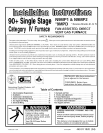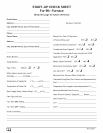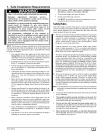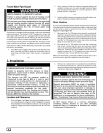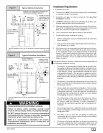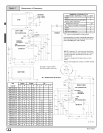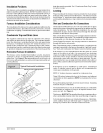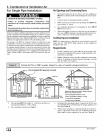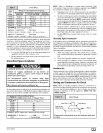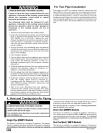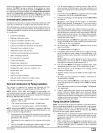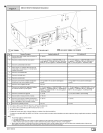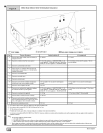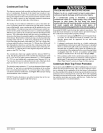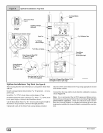
Typical Upflow Installation
Aluminumornon-rustingshield recommended.(See
VentTerminationShieldingfor dimensions).
Coupling on ends of
*8" Min. _l[q _I_ exhaust pipe. Total
20' Max. Inlet Pipe(not
insame _ _ usedon Single pipe & coupling out-
atmospheric <_ __4t_ Pipemodel) side structure =8"
zone
VentPipesMUSTbe
/]in.
supported
andVertically meatmospheric
* Increase minimum from 8" to 18" for cold climates (sustained temperatures below
0 ° F). 25-23-33
Typical Downflow Installation
SeeVentTermination
Shieldingin VentSection.
_1 14' *8" Min.
InletPipe _ [_ 20' Max.
(not usedon _ _ in same
SinglePipe _ I,,,_L, atmospheric zone
model) _
VentPip MUSTbq
support( 4orizonta
andVertically
Coupling on inside
and outside of wall
to restrain vent pipe
Min.
Max.
same
osphericzone
* Increase minimum from 8" to 18" for cold climates (sustained temperatures
below O°F). 25-23-33a
CARBON MONOXIDE POISONING HAZARD.
Failure to follow safety warnings exactly could
result in serious injury, death, or property damage.
Do NOT operate furnace in a corrosive atmosphere
containing chlorine, fluorine or any other damaging
chemicals, which could shorten furnace life.
Refer to 3. Combustion & Ventilation Air section,
Contaminated Combustion Air for combustion air
evaluation and remedy.
Installation Requirements
1. Install furnace level.
2. This furnace is NOT to be used for temporary heat of buildings
or structures under construction.
3. Install the vent pipes as short as practical. (See Gas Vent
Installation section).
4. Do NOT install furnace directly on carpeting, tile or other com-
bustible material other than wood flooring.
5. Maintain clearance for fire safety and servicing. A front clear-
ance of 30" is minimum for access to the burner, controls and
filter. See clearance requirements in Figure 3 or.
6. Use a raised base if the floor is damp or wet at times.
7. Residential garage installations require:
• Burners and ignition sources installed at least 18" (457 ram)
above the floor.
8.
Furnace must be located or physically protected from pos-
sible damage by a vehicle.
If the furnace is to be suspended from the floorjoists in a base-
ment or a crawl space or the rafters in an attic, it is necessary
to use steel pipe straps or an angle iron frame to attach the
furnace. These straps should be attached to the furnace with
sheet metal screws and to the rafters or joists with bolts. The
preferred method is to use an angle iron frame bolted to the
rafters or joists.
I his furnace may be used for construction heat provided that all
the following conditions are met:
The furnace is permanently installed with all electrical wir-
ing, piping, venting and ducting installed according to these
installation instructions. A return air duct is provided, sealed
to the furnace casing, and terminated outside the space
containing the furnace. This prevents a negative pressure
condition as created by the circulating air blower, causing a
flame rollout and/or drawing combustion products into the
structure.
• The furnace is controlled by a thermostat. It may not be "hot
wired" to provide heat continuously to the structure without
thermostatic control.
Clean outside air is provided for combustion. This is to mini-
mize the corrosive effects of adhesives, sealers and other
construction materials. It also prevents the entrainment of
drywall dust into combustion air, which can cause fouling
and plugging of furnace components.
The temperature of the return air to the furnace is no less
than 55 ° F,with no evening setback or shutdown. The use of
the furnace while the structure is under construction is
deemed to be intermittent operation per our installation in-
structions.
• The air temperature rise iswithin the rated rise range on the
furnace rating plate, and the firing rate has been set to the
rating plate value.
• The filters used to clean the circulating air during the
construction process must be either changed or thoroughly
cleaned prior to occupancy.
• The furnace, ductwork and filters are cleaned as necessary
to remove drywall dust and construction debris from all
HVAC system components after construction is completed.
44001 102004 [_



